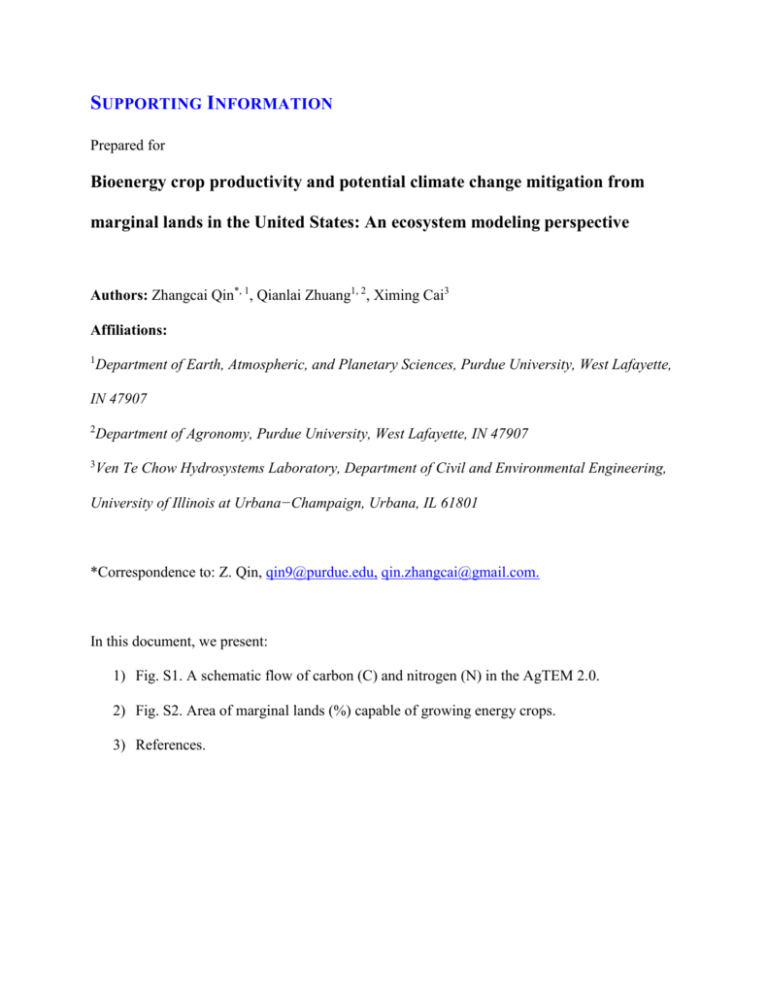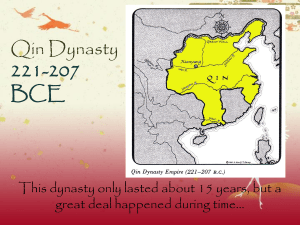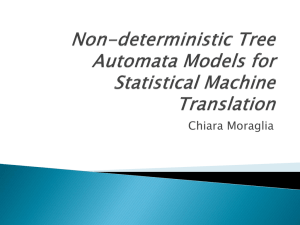gcbb12212-sup-0001-FigS1-S2
advertisement

SUPPORTING INFORMATION Prepared for Bioenergy crop productivity and potential climate change mitigation from marginal lands in the United States: An ecosystem modeling perspective Authors: Zhangcai Qin*, 1, Qianlai Zhuang1, 2, Ximing Cai3 Affiliations: 1 Department of Earth, Atmospheric, and Planetary Sciences, Purdue University, West Lafayette, IN 47907 2 Department of Agronomy, Purdue University, West Lafayette, IN 47907 3 Ven Te Chow Hydrosystems Laboratory, Department of Civil and Environmental Engineering, University of Illinois at Urbana−Champaign, Urbana, IL 61801 *Correspondence to: Z. Qin, qin9@purdue.edu, qin.zhangcai@gmail.com. In this document, we present: 1) Fig. S1. A schematic flow of carbon (C) and nitrogen (N) in the AgTEM 2.0. 2) Fig. S2. Area of marginal lands (%) capable of growing energy crops. 3) References. RA GPP CV RH LC, RC CS H VEGETATION NINPUT LN, RN NAV NS NETMIN NUPTAKE NV SOIL NLOST, NOX Fig. S1 A schematic flow of carbon (C) and nitrogen (N) in the AgTEM 2.0. The AgTEM is based on the Terrestrial Ecosystem Model (TEM), and the C and N cycling in the model follows the general structure in the TEM (Raich et al., 1991; McGuire et al., 1992). Square blocks show state variables of C and N in vegetation and soils. Arrows indicate C and N fluxes; the dashed arrow shows C and N fluxes due to possible harvest (H). GPP, gross primary production; CV, vegetation C; RA, autotrophic respiration; LC, C in litterfall; RC, C in residue return; CS, soil C; RH, heterotrophic respiration; NV, vegetation N; LN, N in litterfall; RN, N in residue return; NS, soil N; NUPTAKE, N uptake by vegetation; NETNMIN, net rate of soil N mineralization; NINPUT, N inputs from outside ecosystem; NLOST, N losses from ecosystem; NOX, nitrogen oxides. More details about AgTEM can be found in Qin et al., 2013a and Qin et al., 2013b. Fig. S2 Area of marginal lands (%) capable of growing energy crops. Data were derived from Scenario 1 of Cai et al., (2011). Marginal lands were identified according to marginal agricultural productivity based on land suitability indicators such as topography, climate conditions and soil productivity. Fuzzy Logic Modeling method was used to determine land productivity (Cai et al., 2011). References Cai X, Zhang X, Wang D (2011) Land availability for biofuel production. Environmental Science & Technology, 45, 334-339. McGuire A D, Melillo J M, Joyce L A et al (1992) Interactions between carbon and nitrogen dynamics in estimating net primary productivity for potential vegetation in North America. Global Biogeochemical Cycles, 6, 101–124. Qin Z, Zhuang Q, Zhu X (2013a) Carbon and nitrogen dynamics in bioenergy ecosystems: 1. Model development, validation and sensitivity analysis. GCB Bioenergy. doi: 10.1111/gcbb.12107. Qin Z, Zhuang Q, Zhu X (2013b) Carbon and nitrogen dynamics in bioenergy ecosystems: 2. Potential greenhouse gas emissions and global warming intensity in the conterminous United States. GCB Bioenergy. doi: 10.1111/gcbb.12106. Raich J W, Rastetter E B and Melillo J M et al (1991) Potential net primary productivity in South America: application of a global model. Ecological Applications, 1, 399–429









